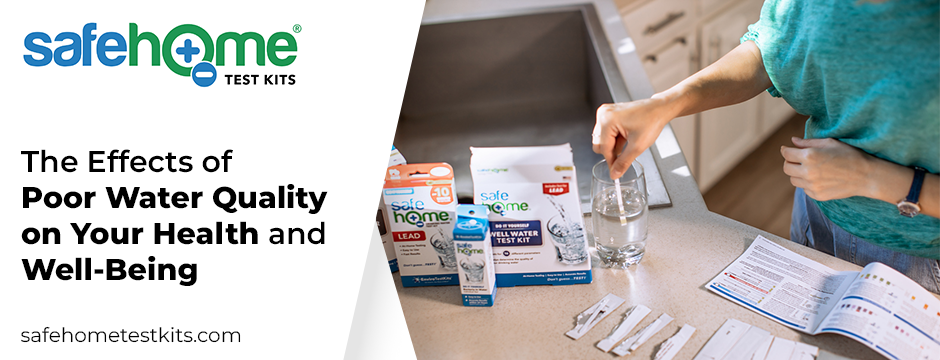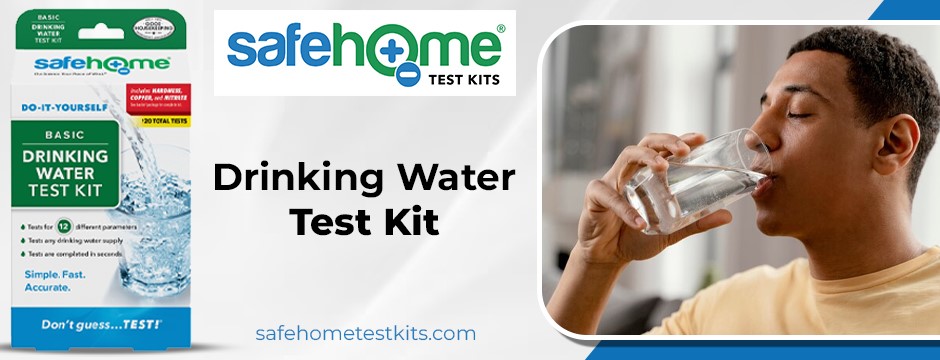The Effects of Poor Water Quality on Your Health and Well-Being

Water is a fundamental element of life, essential for sustaining our well-being. However, the water quality we consume can significantly impact our health. The importance of clean, safe water cannot be overstated, as it influences not only our physical health but also our overall well-being. In this comprehensive guide, we will delve into how poor water quality affects your health, from the obvious immediate effects to the subtle, long-term consequences.
The Importance of Water Quality
Water, the lifeblood of our existence, stands as an essential pillar for human survival. Its significance is profoundly entrenched in its multifaceted roles within our bodies, orchestrating a symphony of vital functions.
Water as a Basic Necessity
Water, with its unparalleled versatility, is an irreplaceable force behind the scenes. It not only aids in the seamless flow of digestion but also ensures the relentless circulation of blood, maintains our body temperature within a narrow window of safety, and facilitates the expulsion of waste from our systems. Its omnipresence in these fundamental functions underscores its role as a basic necessity for human existence.
However, this simple molecule’s vitality is starkly contrasted by the potential consequences of its contamination. Consuming compromised water can swiftly cascade into an array of severe health issues. It is through this lens that we come to appreciate the gravity of safeguarding water quality.
Safe Drinking Water Standards
To safeguard public health and ensure the safety of our communities, governments and organizations worldwide have meticulously defined standards for safe drinking water. These standards, precisely calibrated, serve as sentinels against the infiltration of contaminants and pollutants into the water we consume.
In effect, they prescribe stringent limits on the presence of harmful substances, from toxic chemicals to microorganisms. These standards are not just arbitrary rules but a collective resolve to guarantee the availability of clean, safe water for everyone. They represent the culmination of scientific understanding, public health initiatives, and a commitment to nurturing the well-being of all.
Immediate Health Effects of Poor Water Quality
Waterborne Diseases
Within the murky depths of contaminated water, an invisible army of waterborne diseases lurks, poised to strike unsuspecting victims. Cholera, dysentery, and typhoid, to name but a few, stand as stark examples of these disorders. Consuming water tainted with these pathogens triggers a brutal assault on the human body, resulting in severe bouts of diarrhea, relentless vomiting, and, in the direst of circumstances, death.
The immediacy of these waterborne diseases magnifies the peril of poor water quality. Their swift onset and ruthless progression underscore the urgency of addressing water contamination. It is a stark reminder of how precarious our health can be when exposed to unsafe water sources.
Gastrointestinal Distress
The human gastrointestinal system, though robust, is no fortress against the incursions of waterborne contaminants. In the face of contamination, it often responds with immediate distress signals. Nausea, a miserable sensation within itself, can quickly give way to stomach cramps, wrenching and persistent. These uncomfortable sensations are often joined by their relentless companion, diarrhea, which rapidly depletes the body of vital fluids and nutrients. The cumulative impact of these gastrointestinal woes can be debilitating, robbing individuals of their well-being and vitality. The discomfort is a potent reminder that the consequences of poor water quality are not distant abstractions but tangible afflictions.
Skin Irritation
Poor water quality’s toll isn’t confined to our internal systems. It extends to our external defenses, the skin. When utilized for bathing and washing, contaminated water can lead to skin irritations and rashes. The skin, a vital organ, stands as a sentinel against external threats, but it, too, succumbs to the presence of harmful contaminants.
These rashes and irritations, though not life-threatening, are a testament to the profound effects of water quality on our immediate well-being. They are the external manifestations of internal battles, a visual reminder of the importance of safeguarding our water sources.

Long-Term Health Effects of Poor Water Quality
Chronic Health Conditions
The repercussions of poor water quality extend far beyond immediate discomfort, seeping insidiously into the realm of chronic health conditions. Exposure to contaminants, often due to prolonged consumption of tainted water, can take a heavy toll on human health. Some common culprits, such as arsenic, lead, and nitrates, have forged insidious links to a spectrum of chronic disorders. These include cancer, cardiovascular diseases, and developmental issues in children. These health conditions are not the swift adversaries of acute waterborne diseases but persistent, lurking threats that emerge over time. They serve as a stark reminder that the consequences of water contamination are not confined to the present moment; they can cast a long, enduring shadow over an individual’s lifetime.
Impaired Cognitive Function
Within the complex landscape of water contaminants, the presence of certain heavy metals stands as a particularly ominous specter. Notably, they are known to possess the sinister ability to infiltrate the intricate workings of the human brain, affecting cognitive function. Children, in particular, bear the brunt of this threat. Prolonged exposure to notorious heavy metals like lead has been inextricably linked to decreased IQ, behavioral problems, and intellectual handicaps. The consequences of impaired cognitive function are profound, extending into educational and social realms, thereby threatening the well-being of future generations.
Reproductive Health Concerns
The intricate processes of human reproduction also stand vulnerable to the insidious influence of water contaminants. Among the cast of villains are endocrine-disrupting chemicals, subtle yet potent agents that can unravel the delicate threads of reproductive health. These contaminants, when present in water sources, can instigate a cascade of reproductive issues, ranging from fertility problems to developmental complications in unborn children. The potential ramifications extend beyond the immediate generation, casting a shadow over the reproductive health of future populations. This peril underscores the interconnectedness of water quality and the well-being of communities, present and future.
The Impact on Vulnerable Populations
Children
The vulnerability of children to the effects of poor water quality is particularly pronounced. Their developing bodies and nascent immune systems make them more susceptible to the health impacts of contaminants. Whether through direct consumption or exposure through bathing and daily activities, children are at a heightened risk of experiencing the immediate and long-term health effects of water contamination. As a society, we bear the collective responsibility of safeguarding the health of the youngest members of our communities.
Elderly Individuals
Elderly individuals, too, stand at the intersection of heightened susceptibility and accumulated health vulnerabilities. With weakened immune systems and age-related frailties, they may be more susceptible to waterborne illnesses and long-term health issues related to water quality. It is imperative to recognize the unique needs of this demographic and ensure that their access to safe and clean water remains uninterrupted. The consequences of failing to do so can be severe, affecting not only their quality of life but also placing an added burden on healthcare systems already stretched thin. Protecting elderly individuals’ health underscores the far-reaching consequences of ensuring water quality for all.
Social and Economic Consequences
Economic Burden
The impact of poor water quality transcends physical well-being, cascading into the realm of economics. Communities and individuals bear a substantial economic burden, chiefly due to increased healthcare costs and the insidious loss of productivity. The financial strain imposed by the treatment of waterborne diseases is staggering. The costs associated with medical consultations, hospital stays, medications, and the indirect costs of lost workdays can drain resources and undermine economic stability. This dual-edged sword of diminished health and economic hardship underscores the profound and interconnected effects of water quality on communities.
Social Inequities
The quest for access to clean water needs to be more equitable, carving deep social divides. Across communities, the privilege of enjoying safe water is distributed unevenly, perpetuating social inequities. Marginalized and low-income populations often bear the brunt of the health consequences of poor water quality. These communities, already grappling with multiple challenges, are further burdened by the weight of waterborne diseases, with limited access to adequate healthcare resources. Thus, the specter of poor water quality exacerbates pre existing social inequalities, underlining the urgency of universal access to clean and safe water.
Protecting Your Water Quality
Water Testing
The safeguarding of water quality commences with vigilance and the proactive pursuit of knowledge. Regular water testing is an essential practice to monitor the quality of the water flowing from your taps. This process serves as a sentinel, identifying potential contaminants that may have infiltrated your water source. By identifying these intruders promptly, individuals and communities can take corrective measures to mitigate risks to health and well-being. Water testing is not merely an act of responsibility; it is a potent tool for empowerment, allowing individuals to actively participate in preserving their health.
Filtration and Treatment
Maintaining water quality is a multifaceted endeavor, demanding a suite of strategies and tools. Among these, water treatment methods stand as bulwarks against contamination, fortifying water quality. Various filtration systems, from simple pitchers equipped with specialized filters to comprehensive whole-house filtration systems, have been designed to cater to diverse needs. By incorporating such systems, individuals and communities can effectively remove contaminants, restore the pristine character of water, and shield health from harm. The implementation of filtration and treatment solutions serves as an active commitment to the preservation of water quality and, by extension, the well-being of society.

Safe Home® BASIC 120 Drinking Water Test Kit: Your Gateway to Water Quality Assurance
Water quality is fundamental to our well-being. The Safe Home® BASIC 120 Drinking Water Test Kit, priced at $12.99, empowers you to assess your daily water source comprehensively. This DIY kit provides 120 tests for 12 essential parameters, ensuring your water meets the highest safety and purity standards. Parameters include chlorine, nitrite, fluoride, and more. You’ll gain quick, accurate insights into your water’s safety and purity, enhancing peace of mind. The kit is user-friendly, suitable for households and businesses, and has everything you need. It’s a cost-effective solution that doesn’t require professional expertise. With the Safe Home® BASIC 120 Water Quality Test Kit, you can enjoy safe, pure, and high-quality drinking water with confidence.
Conclusion
Water quality is a crucial factor that affects our health and well-being. Ensuring access to clean, safe water is not only a matter of public health but a fundamental human right. By understanding the effects of poor water quality on our health and taking steps to protect our water sources, we can mitigate its harmful consequences. Ultimately, clean water is the foundation of a healthy and thriving society.


